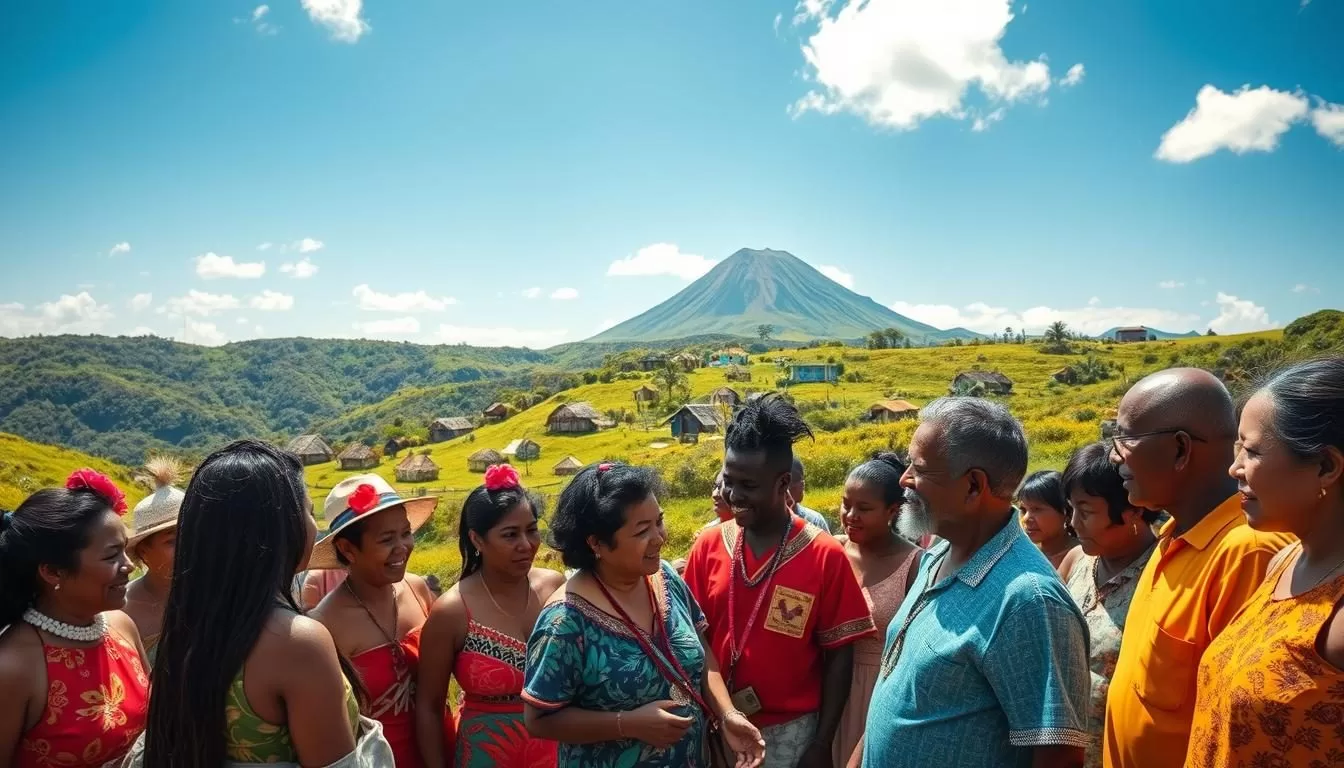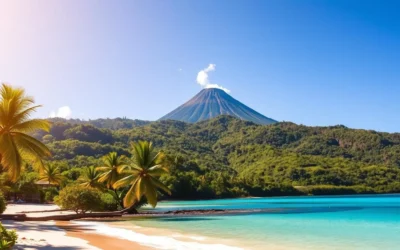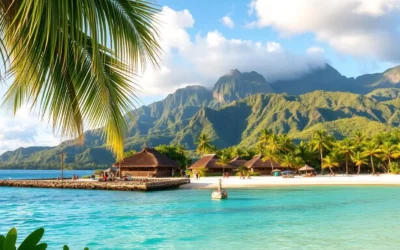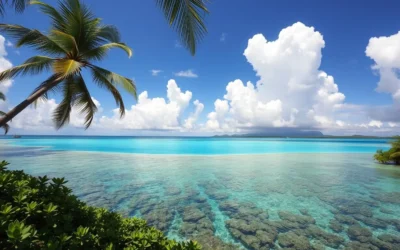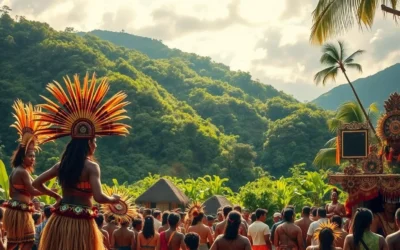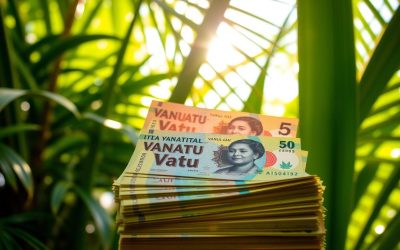✓ Tours & Activities ✓ Tours & Activities
Did you know that a small country in the Pacific is home to one of the most diverse linguistic landscapes in the world? With a population of less than 300,000, this nation boasts an astonishing 138 indigenous languages, making it the highest linguistic density per capita globally.
What makes this place truly unique is its three official languages: English, French, and Bislama. Bislama, a creole derived from English, is the most commonly spoken, especially in urban areas. This blend of languages reflects the rich cultural and historical tapestry of the region.
Exploring this linguistic heritage offers a fascinating glimpse into how language shapes identity and communication. Stay tuned as we dive deeper into the stories behind these tongues and their significance in everyday life.
Introduction to Vanuatu’s Linguistic Landscape
In the heart of the Pacific, a unique linguistic tapestry unfolds. This archipelago of 83 islands is home to a rich cultural heritage, where over 100 indigenous tongues coexist. Each island tells its own story through its words, reflecting a blend of traditions and histories.
The origins of these languages are deeply rooted in both indigenous traditions and colonial influences. British and French rule left their mark, shaping the way people communicate today. This mix of cultures has created a vibrant linguistic environment that is truly one of a kind.
Overview of the Archipelago and Its Cultures
With a population of around 341,500, this nation is a melting pot of traditions. From the northern islands with their distinct phonetic sounds to the southern regions, every area has its own flavor. The languages spoken here are more than just tools for communication—they are a reflection of identity.
Why Language Matters in Vanuatu
Language is the heartbeat of cultural identity. It connects people to their roots and defines community practices. For many, it’s a way to preserve their heritage and pass it on to future generations. This is why understanding the linguistic landscape is so important.
- Languages reflect the history and origin of the islands.
- They play a key role in daily life, from family gatherings to community events.
- Each person’s name and story are tied to the language they speak.
Exploring this linguistic diversity offers a glimpse into the soul of the islands. It’s a journey through time, culture, and identity that you won’t soon forget.
Historical Background of Vanuatu’s Languages
The story of language in this Pacific nation is deeply tied to its history. Over time, the islands have seen a fascinating evolution in how people communicate. From ancestral tongues to modern creoles, the linguistic journey here is remarkable.
Colonial Legacies and Language Adoption
Colonial influences played a major role in shaping the way people speak today. British and French rule introduced English and French, which became official languages. These languages were widely used in governance, education, and trade.
At the same time, Bislama emerged as a creole, bridging local and colonial language use. It started as a pidgin for trade but evolved into a widely spoken tongue. Today, it’s a key part of daily life in urban and rural areas.
The Evolution of Language Across the Islands
Historical events have left a lasting mark on the way words are used across the islands. Ancestral communication methods blended with introduced languages, creating a unique linguistic tapestry. This blend is especially evident in homes, where multiple languages are often spoken.
Over time, Bislama became a unifying force. It allowed people from different regions to communicate effectively. This evolution reflects the resilience and adaptability of the islanders.
- Colonial powers shaped the adoption of English and French.
- Bislama evolved from a pidgin to a widely used creole.
- Ancestral and introduced languages blend in homes across the islands.
Understanding this history gives you insight into how time and context have shaped the linguistic practices you see today.
Vanuatu: Official and Widely Spoken Languages
The linguistic diversity of this Pacific nation is both fascinating and complex. With three official tongues—Bislama, English, and French—the country bridges its rich heritage with modern communication needs. Bislama, a creole language, is the most commonly used, especially in urban areas.
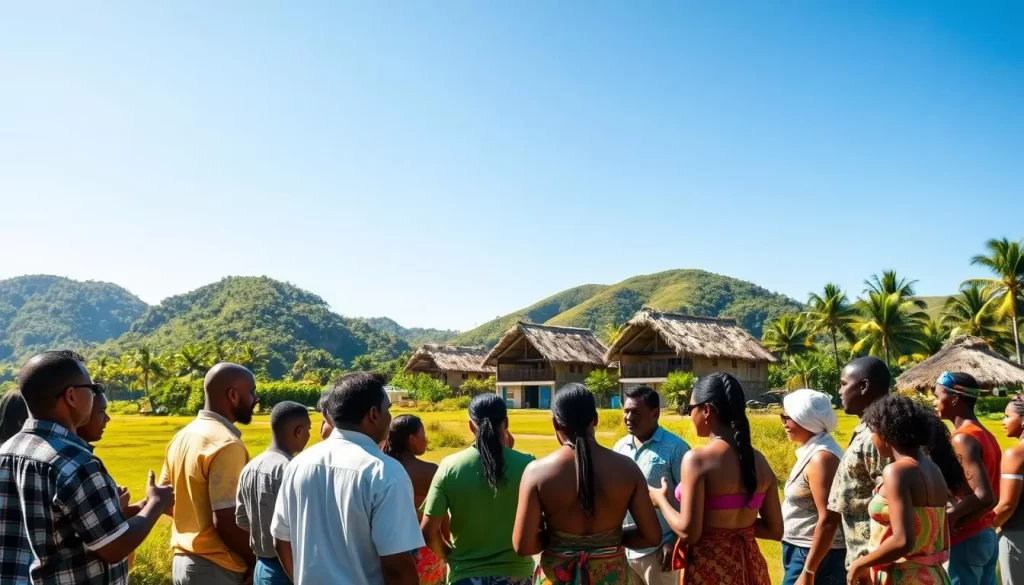
In schools, English and French are the primary mediums of instruction. Over the years, the number of students learning these languages has steadily increased. This trend reflects their importance in formal education and future opportunities.
Despite the prominence of these official tongues, over 110 indigenous languages thrive across the islands. This high number highlights the cultural richness of the region. However, many of these local languages face challenges in preservation.
- Bislama serves as a unifying language in daily life.
- English and French dominate in schools and official settings.
- Indigenous languages remain vital for cultural identity.
Statistical data from recent years shows a shift in language use. For example, the percentage of people speaking indigenous tongues as their first language has declined. This change underscores the need for efforts to preserve these unique voices.
Understanding this linguistic landscape offers insight into how language shapes identity and community. Whether in schools, homes, or public spaces, each tongue tells a story of resilience and adaptation.
Bislama: The Creole Bridge of Communication
Bislama, a creole language, has become a vital bridge for communication in the Pacific. It connects people across diverse linguistic backgrounds, making it a cornerstone of daily life. Derived from English, it blends simplicity with cultural richness, serving as a first language for many in urban areas.
Origins and Evolution of Bislama
Bislama’s roots trace back to the 1800s, emerging during trade interactions. It started as a pidgin for sea cucumber trading and evolved into a full-fledged creole. Over time, it absorbed vocabulary from English, French, and local languages, creating a unique linguistic blend.
During the blackbirding period, workers from different islands used Bislama to communicate. This situation helped it grow into a lingua franca. Today, it’s one of the three official languages, reflecting its importance in national identity.
Practical Day-to-Day Communication
In daily life, Bislama plays a key role in family conversations and community interactions. Its simplified grammar makes it easy to learn and use. For example, verbs don’t change for tense, and plural nouns are formed by adding “ol” before the noun.
In urban areas like Port Vila, it’s often the first language for residents. It’s also used in official documents, public notices, and health information. This widespread use highlights its practicality in various situations.
| Feature | Description |
|---|---|
| Vocabulary | 95% derived from English, 5% from French and local languages |
| Grammar | Simplified; verbs don’t change for tense |
| Usage | Lingua franca in urban and rural areas |
Bislama’s role in family and community life is undeniable. It fosters connections and preserves cultural identity. Whether in homes, markets, or schools, it remains a vital part of everyday communication.
The Importance of English in Vanuatu
English plays a pivotal role in shaping the formal sectors of this Pacific nation. As an official language, it is deeply embedded in education, governance, and business. This influence ensures that English remains a key tool for progress and development.
Role in Education, Government, and Business
In schools, English is the primary medium of instruction. Students are required to complete courses like LLF11: Communications and Study Skills, which prepare them for academic success. This focus on English helps bridge gaps in literacy and opens doors to higher education opportunities.
In government, English is used in official documents and policies. A single word in English can shape decisions that impact the entire nation. This highlights its strategic importance in administration and public communication.
Businesses across the islands rely on English for trade and international relations. It serves as a common ground for negotiations and partnerships. This widespread use underscores its value in economic growth and global connectivity.
- English is essential in schools, with courses like LLF11 and LL114 focusing on communication skills.
- Government policies and documents are often drafted in English, ensuring clarity and consistency.
- Businesses use English to facilitate trade and build international relationships.
Understanding the role of English in these sectors gives you insight into its significance. Whether in classrooms, offices, or boardrooms, English is a driving force for development and unity.
French Influence and Cultural Integration
The French language has left a lasting mark on the cultural fabric of this Pacific archipelago. Its presence is a testament to the history of colonial rule and the ongoing ties with France. Today, French is spoken primarily in the southern islands, where its influence remains strong.

French culture intermingles seamlessly with indigenous traditions. From cuisine to art, the blend creates a vibrant and dynamic society. For example, local festivals often feature French-inspired music and dance, showcasing this unique fusion.
In government and education, French plays a significant role. Official documents are often drafted in both French and English, reflecting its official status. Schools also teach French, ensuring that younger generations maintain this linguistic connection.
The balance between indigenous practices and foreign legacy is delicate but harmonious. French is not just a language—it’s a bridge between history and modernity. This integration highlights the resilience and adaptability of the islanders.
Understanding this blend of culture and language offers insight into the soul of the islands. It’s a story of connection, identity, and shared heritage that continues to evolve.
Indigenous Languages: A Rich Tapestry of Diversity
Imagine a place where every corner of an island speaks a different tongue, creating a vibrant mosaic of communication. This is the reality of a Pacific nation with over 138 indigenous languages, each carrying its own unique story. These languages are more than just words—they are the heartbeat of cultural identity.
An Overview of the 138 Indigenous Languages
With a population of around 300,000, the linguistic density here is unmatched. Each language reflects the traditions, history, and identity of its speakers. From the northern islands to the southern regions, the diversity is staggering. This richness is a testament to the resilience of indigenous cultures.
However, many of these languages face challenges today. Urbanization and globalization have led to a decline in native speakers. Younger generations often prioritize Bislama, English, or French, leaving indigenous tongues at risk of fading away.
Preservation Efforts and Challenges
Preserving these languages is crucial for maintaining cultural heritage. Education plays a key role in this effort. Schools are increasingly incorporating indigenous languages into their curricula, ensuring that children learn their ancestral tongues.
The government has also stepped in with policies to support language preservation. Initiatives like community workshops and cultural festivals aim to revive interest in these languages. Despite these efforts, challenges remain, such as limited resources and the dominance of global languages.
“Language is the roadmap of a culture. It tells you where its people come from and where they are going.”
Here are some key strategies being used today to preserve indigenous languages:
- Integrating local languages into education systems.
- Supporting community-led language programs.
- Documenting languages through recordings and written materials.
| Strategy | Impact |
|---|---|
| School Programs | Increases youth engagement with indigenous languages |
| Community Workshops | Encourages intergenerational language transmission |
| Government Policies | Provides funding and resources for preservation efforts |
Understanding the importance of these languages helps us appreciate the cultural richness they represent. Through education and government support, there is hope for their survival. Every word preserved is a step toward safeguarding a unique heritage.
Linguistic Diversity and Cultural Identity
The connection between language and culture is a powerful force in shaping identity. In this Pacific nation, over 138 indigenous languages create a vibrant tapestry of communication. Each language reflects the traditions, history, and values of its speakers, making them essential to cultural heritage.
This incredible linguistic diversity influences how communities interact and bond. People often use their native tongues to express emotions, share stories, and pass down traditions. This strengthens relationships and fosters a sense of belonging.
How Language Shapes Community and Heritage
Grammatical structures in local languages reveal unique cultural identities. For example, some languages use specific verb forms to show respect or hierarchy. These nuances highlight the importance of grammar in understanding cultural values.
Languages also play a key role in shaping traditions. Rituals, ceremonies, and even daily practices are often conducted in native tongues. This ensures that cultural heritage remains alive and relevant.
Here are some ways diversity in language impacts cultural identity:
- It preserves ancestral stories and land connections.
- It fosters pride and unity within communities.
- It encourages intergenerational learning and sharing.
Real-life examples show how language reinforces community identity. For instance, festivals often feature songs and dances performed in local dialects. This celebrates diversity while strengthening cultural bonds.
| Aspect | Impact |
|---|---|
| Grammatical Structures | Reflect cultural values and social hierarchies |
| Community Bonds | Strengthened through shared language practices |
| Cultural Preservation | Ensures traditions are passed down through generations |
Understanding the role of language in shaping identity helps you appreciate its significance. Every word spoken is a step toward preserving a unique cultural legacy.
Language in Education and Public Policy
Education and public policy play a crucial role in shaping how languages are used and preserved in this Pacific nation. The integration of language into these systems reflects a balance between tradition and modernity. Schools emphasize English and French, while local languages remain vital in homes and communities.
In classrooms, English and French dominate as the primary mediums of instruction. This approach ensures students gain proficiency in these official languages, which are essential for higher education and global opportunities. However, there is a significant gap between formal education and the use of local languages at home.
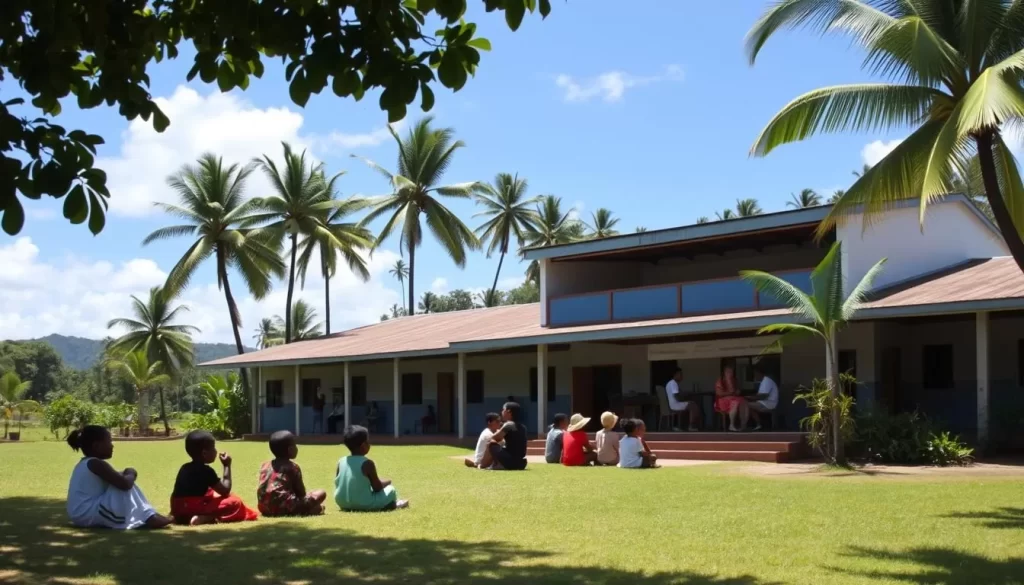
Policy reforms aim to bridge this gap. The Vanuatu National Language Policy supports bilingual education, recognizing the importance of local vernaculars and Bislama. This policy ensures equitable access to language education for all students.
Here are some key aspects of language integration in education:
- English and French are used in formal settings, while local languages aid understanding in early years.
- Teachers who know the vernacular are better equipped to connect with students.
- Community workshops and cultural festivals promote the use of indigenous languages.
Efforts to preserve local languages face challenges. Urbanization and globalization have led to a decline in native speakers. Younger generations often prioritize English or French, leaving indigenous tongues at risk.
Understanding this dynamic helps you appreciate the complexity of language in education and policy. Every reform and initiative is a step toward preserving a unique cultural heritage.
Migration and Its Impact on Language Use
Migration has always been a driving force behind the evolution of language in this Pacific archipelago. Recent movements have introduced new tongues like Samoan, Hakka Chinese, and Mandarin Chinese, reshaping the local linguistic landscape. These changes reflect the dynamic nature of communication in a place where cultures constantly intersect.
Influences from Recent Migrations
Migrant communities bring more than just their traditions—they introduce fresh linguistic elements. For example, Mandarin Chinese has become a part of daily life in urban areas, influencing local dialects and trade practices. This blending of languages creates a unique environment where old and new coexist.
Traditional communication methods are also evolving. Bislama, the national language, now incorporates words from Samoan and Hakka Chinese, showing how migration fosters linguistic adaptation. This process highlights the resilience of local communities in maintaining cultural cohesion amid diverse language contact.
Here are some key ways migration impacts language use:
- New languages enrich the local vocabulary, adding depth to everyday conversations.
- Migrant communities often create bilingual spaces, blending their native tongues with local dialects.
- Language shift occurs as younger generations adopt dominant languages for social and economic opportunities.
Understanding these changes helps you appreciate the complexity of spoken Vanuatu today. Migration not only brings new words but also reshapes how people connect in this vibrant place.
For more insights into the historical context of migration, explore this study on the genetic history of the region.
Effects of Language Shift on Indigenous Communities
Language shifts are reshaping the way communities connect and preserve their heritage. The increasing adoption of Bislama as a first language is transforming cultural dynamics, especially in urban areas. This change is influencing daily life, from family conversations to community events.
One major influence is the decline in the use of indigenous languages. For example, on Tanna Island, where Kwamera is spoken by around 3,500 people, younger generations are increasingly favoring Bislama. This shift threatens the vitality of local dialects and the traditions they carry.
Communities face real challenges in balancing modern language shifts with traditional practices. While Bislama offers a unifying form of communication, it can overshadow indigenous languages. This creates a tension between preserving cultural identity and adapting to global trends.
Here are some key impacts of language shift:
- Indigenous languages are losing their role in daily communication.
- Cultural practices tied to local dialects are at risk of fading.
- Younger generations may feel disconnected from their heritage.
The social and cultural consequences of favoring one language form over others are significant. For instance, traditional ceremonies often rely on specific linguistic nuances that Bislama cannot fully capture. This loss affects the richness of cultural expression.
| Aspect | Impact |
|---|---|
| Language Retention | Decline in native speakers of indigenous languages |
| Cultural Heritage | Loss of traditions tied to local dialects |
| Community Identity | Shift in how people connect with their roots |
Understanding these changes helps you appreciate the complexity of language shifts. While Bislama offers opportunities for unity, it also poses threats to the preservation of unique cultural voices. Every word lost is a step away from a rich heritage.
Understanding Bislama Grammar
Bislama’s grammar is a fascinating blend of simplicity and structure, making it unique among creole languages. Its straightforward rules make it accessible for learners, while its nuances reflect the vibrant culture of the archipelago. Let’s dive into the basics of sentence construction and how tense, negatives, and transitive verbs work in Bislama.
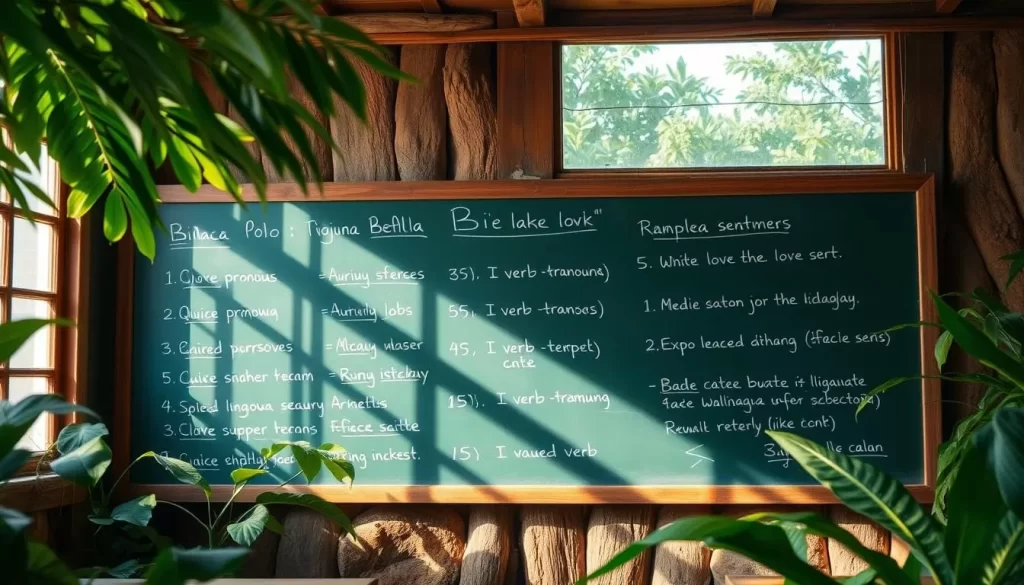
Basic Sentence Structures and Tense
Bislama doesn’t use a traditional “to be” verb. Instead, the word “i” serves as a marker for tense and aspect. For example, “Mi i go” translates to “I go” or “I am going,” depending on the context. This flexibility allows speakers to convey actions without complex verb conjugations.
To indicate tense, Bislama uses auxiliary words. “Bin” marks the past tense, as in “Mi bin go” (I went). For the future, “bambae” is used, like in “Mi bambae go” (I will go). These simple markers make it easy to express time without altering the verb itself.
Negatives and Transitive Verbs in Practice
Negation in Bislama is straightforward. The word “no” is placed before the verb, as in “Mi no go” (I do not go). This simplicity ensures that even beginners can form negative sentences with ease.
Transitive verbs, which require an object, are marked with endings like “-em,” “-im,” or “-um.” For example, “Mi lukim yu” means “I see you.” These endings help clarify the relationship between the verb and its object.
Here are some key points to remember about Bislama grammar:
- Use “i” to mark tense and aspect instead of a “to be” verb.
- “Bin” indicates past actions, while “bambae” is used for the future.
- Negatives are formed by placing “no” before the verb.
- Transitive verbs often end with “-em,” “-im,” or “-um.”
By understanding these rules, you’ll gain insight into how Bislama speakers communicate in their daily lives. Its grammar reflects the adaptability and creativity of the archipelago’s culture, making it a truly unique language to explore.
Language Use in Daily Life: From Home to School
From homes to schools, language plays a central role in daily life. In this region, communication is a blend of tradition and practicality. Bislama, often a second language, is the go-to choice for many, especially in urban areas.
In homes, families often switch between Bislama and local dialects. This mix reflects the cultural richness of the region. For example, parents might use Bislama for general conversations but switch to a local language for storytelling or traditions.
Schools also reflect this linguistic diversity. While English and French are the primary mediums of instruction, Bislama is often used to help students understand complex concepts. This approach ensures that education is accessible to all, regardless of their second language proficiency.
In marketplaces, Bislama shines as a unifying tongue. Vendors and buyers from different linguistic backgrounds rely on it for smooth transactions. This practical use makes it a vital part of daily interactions.
Here’s a quick look at how languages are used in different settings:
| Setting | Primary Language | Secondary Language |
|---|---|---|
| Homes | Local Dialects | Bislama |
| Schools | English/French | Bislama |
| Markets | Bislama | Local Dialects |
Understanding these patterns helps you see why Bislama maintains its status as the leading language in day-to-day communication. Its adaptability and simplicity make it a bridge between cultures and generations. For more on Bislama grammar basics, explore this detailed guide.
Preserving Linguistic Heritage Through Culture and History
Cultural traditions hold the key to preserving linguistic diversity in this Pacific nation. From festivals to storytelling, these practices ensure that indigenous languages remain alive. They provide a sense of order and continuity, connecting communities to their roots.
One of the most effective ways to maintain linguistic status is through community events. Festivals often feature songs, dances, and rituals performed in local dialects. These celebrations not only honor cultural heritage but also encourage younger generations to embrace their native tongues.
Educational programs also play a vital role. Schools are increasingly incorporating indigenous languages into their curricula. This approach ensures that children learn their ancestral languages alongside official ones. It’s a structured effort to uphold linguistic order in the face of modern challenges.
Local media, such as radio shows and newspapers, further support these efforts. They provide platforms for native speakers to share stories and news in their languages. This variety of initiatives helps maintain the cultural richness of the region.
Here are some key strategies for preserving linguistic heritage:
- Community festivals that celebrate local dialects.
- Educational programs integrating indigenous languages.
- Media platforms dedicated to native language content.
Historical continuity is essential for the survival of these languages. Many communities trace their traditions back centuries, ensuring that their linguistic heritage remains intact. This connection to the past strengthens their cultural status today.
For more insights into the importance of preserving endangered languages, explore this detailed guide.
| Initiative | Impact |
|---|---|
| Community Festivals | Encourage intergenerational language use |
| School Programs | Increase youth engagement with native languages |
| Local Media | Provide platforms for native language content |
By embracing these efforts, communities ensure that their linguistic heritage thrives. The variety of traditions and initiatives reflects their commitment to preserving a unique cultural legacy.
Future Trends and Challenges in Vanuatu’s Language Landscape
Global influences are reshaping how communities communicate in this Pacific nation. The rise of creole languages like Bislama reflects a dynamic response to these changes. As migration and globalization increase, the linguistic landscape continues to evolve.
One major challenge is the shift toward dominant languages. Younger generations often prioritize Bislama, English, or French, leaving indigenous dialects at risk. This trend highlights the need for innovative strategies to preserve linguistic heritage.
Studies reference emerging patterns in language use. For example, urban areas show a higher adoption of Bislama, while rural communities maintain stronger ties to local dialects. This divide underscores the complexity of balancing tradition and modernity.
Government and educational institutions are stepping up to address these challenges. Policies now focus on integrating indigenous languages into school curricula. Community programs also aim to revive interest in native tongues.
Continued contact with other cultures will further shape the linguistic future. For instance, the influence of global languages like Mandarin and Samoan is growing. This interaction creates opportunities for cultural exchange but also poses risks to local dialects.
“Language is not just a tool for communication; it’s a bridge to our past and a pathway to our future.”
To enhance linguistic resilience, communities are exploring creative solutions. Digital platforms, for example, are being used to document and teach indigenous languages. These efforts ensure that cultural heritage remains alive for future generations.
Understanding these trends helps you appreciate the evolving role of language in this region. By embracing innovation and tradition, communities can navigate the challenges ahead. For more insights, explore the rich linguistic history of Vanuatu.
Conclusion
Exploring the linguistic landscape of this Pacific nation reveals a unique blend of tradition and modernity. With over 100 indigenous languages, the cultural richness is unparalleled. Bislama, English, and French serve as bridges, connecting communities while preserving heritage.
Language practice is vital for maintaining this diversity. It fosters cultural exchange and strengthens identity. Whether in schools, homes, or public spaces, each tongue tells a story of resilience and adaptation.
To deepen your understanding, explore further sources on this topic. The interplay of official and indigenous languages offers a fascinating model of linguistic diversity. Continue engaging with this rich heritage to appreciate its significance fully.
For more insights, visit this detailed guide on the nation’s linguistic history. Embrace the practice of learning and sharing to keep these voices alive for future generations.
The above is subject to change.
Check back often to TRAVEL.COM for the latest travel tips and deals.
